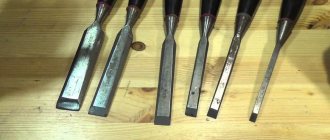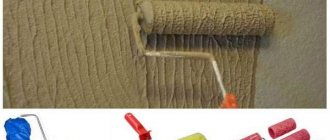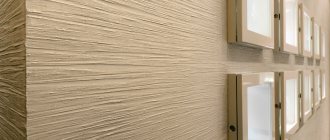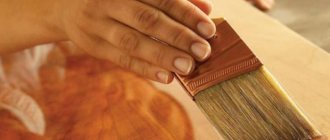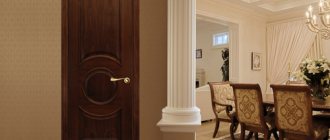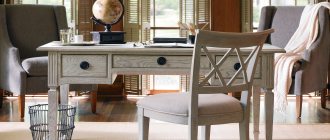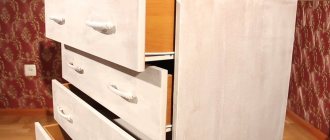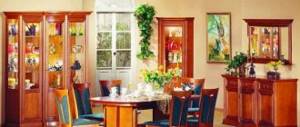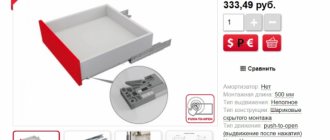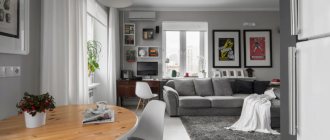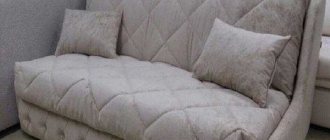DIY redesign: how to repaint a cabinet in an hour
Have you ever experienced this itch in your hands and a strong desire to create something with that old wardrobe or chairs that you inherited and are an eyesore with their imperfections?
Or do you just understand that you want changes, but you’re not ready to invest in a complete replacement of the interior?
There is a solution: take a close look at the items you want to update, come up with a concept and go to the store.
Because it’s very easy to take and paint furniture that you’re tired of!
"Craft" chalk paints
It must be said right away that “craft” chalk paint is also paint. Craft chalk paints, by design, should be different from industrially produced paints. In Russian, the word “craft” often takes on the meaning of exclusivity and exclusivity of the product. Marketers take advantage of this, easily changing the hackneyed “designer” and “exclusive” to “craft”.
The word "craft" comes from the English "craft" (craft). The buyer is promised high quality and uniqueness, and the small production volume allows for complete control over quality. This word is often used to denote exclusivity. But is this really so? Let's find out!
25 signs of “craft” chalk paint:
1. Microscopic share of the total production volume in the paint and varnish industry. The share fluctuates around 1% . This is always small-scale production, one hundred or two kilograms per month.
2. As a rule, this is an independent manufacturer, external control over which can be no more than 25% . The external controller is most often some large manufacturer in the industry or an ordinary investor who actually participates only with capital and who does not have any real influence.
3. Traditional or innovative ingredients are used. Innovative - rare, because craft production often does not have the resources for innovation. But traditional ones are always welcome! - although they may become outdated, because The chemical industry does not stand still and what was in demand and very popular yesterday is now obsolete and generally considered dangerous.
4. The author's unique quality of chalk paint, which is almost impossible to replicate by large manufacturers. Large manufacturers simply will not change their already proven and proven recipes, which are also economically profitable. But they don’t refuse to participate in a micro-project.
5. The presence of a certain percentage of production defects due to technology violations. This is a real problem that crafters will never be able to get rid of. Stable quality is ensured by equipment, technologies, chemists, laboratories, for which they unfortunately do not have enough resources.
6. Experimental approach to the product “by eye” . Each batch of chalk paint is somewhat of a one-of-a-kind product. In artisanal conditions, it is most often not possible to measure a substance with pinpoint accuracy, measure time, revolutions, etc. Of course, some craft producers have outsourced production, which partially solves the problem. Why partially? Because they, as customers, are not allowed into the workshops near the conveyors, which means there is no opportunity to carry out control personally. And quality control is everything to us.
7. An unusual and unique paint property from other manufacturers. This is just about uniqueness. If you are an experienced decorator and are looking for something new, then crafters can offer you something truly new and original. This means this is a chance for a designer to reach a new level.
8. Lack of real legal guarantees and manufacturer's responsibility to the consumer. More precisely, they exist, but more often on words, labels and websites in electronic form. To be fair, it must be said that over time, craft producers have improved the legal framework and are increasingly ready to bear responsibility. And in order for it to decrease, they extract quality as best they can.
9. Impossibility of 100% repetition of the previous batch in composition, properties and color. As a rule, colors from different batches differ. Most often, a craft beer producer does not have arbitration samples. Arbitration sample - a sample of paint, sealed in a sealed package, with marks about the batch in case of detection of defects. The arbitration sample is stored for as long as the guarantee lasts - on average from 1 to 3 years.
10. There are artisans who work without the use of special equipment (the so-called “mixer-blender” kneading). Sometimes these manufacturers use kitchen mixers and blenders and call them small dissolvers. And your own kitchen is a workshop.
11. The shelf life is significantly less than usual by 10 times . Large manufacturers guarantee the viability of their paint in an open can for several years; in fact, these periods are even longer, while craft paint can deteriorate in just six months. Spoilage occurs due to savings, for example on container preservatives and other functional additives. There are manufacturers who have never even heard of them.
12. More often, paint is made to order, so manufacturers almost never have inventory. This means that there are delivery delays or rushed “night” production, without regard to technology (time is running out).
13. Delays in production and further delivery to the consumer. This is a corollary from the previous point. But, in fairness, it must be said that this is happening less and less.
14. Violation of sanitary and epidemiological conditions at work. Always remember that production can easily be located in the manufacturer’s apartment and adjacent to his refrigerator or bed. But this is not a problem if the artisan is honest and monitors cleanliness.
15. Consumers bear some risk associated with VOCs in paint. Artisanal paint is generally not certified. Therefore, it is not clear what it turned out to be in the end: for internal or external work.
16. The manufacturer does not have certificates of product compliance with the level of safety and environmental friendliness. By the way, Athena's Life chalk paint has a certificate of conformity confirming its safety.
17. Confusion in pricing policy. Prices are constantly changing, various discount coupons and other giveaways are given out. Craft producers buy raw materials in small batches, which means that their suppliers set different prices for them each time, and this already ricochets into the cost and final price. In this regard, sometimes there is real chaos. Yes, a crafter can work stably, but sometimes this happens even at a loss.
18. Non-standardized system for replacing paint components. You can’t just take and replace even one component, or simply use the same raw materials, but from a different manufacturer. But crafters do this, and what’s most interesting is that they succeed most often!
19. Craft chalk paints have approximately the same palette as those from industrial manufacturers. Sometimes a little more, but still about 40 colors.
20. Sometimes there are conflicts between one color and another. The paint may react and the coating will deteriorate. And this happens due to the use of low-quality coloring pigments and mass markets.
21. Manual filling and capping , as a rule, leaves traces of small splashes. Of course, no one will know exactly how the product was packaged; it all depends on the accuracy of the manufacturer.
22. There are no control measurements and tests of the composition during the production process. This also relates to the issue of control. Well, imagine, there was a recoloring - should we dispose of 100 liters of the product or try to whiten it? For a large manufacturer, this issue is not even discussed - destroy it. And for small ones, it’s probably whitened, or something needs to be invented.
23. There is no control staining of chess paper to determine hiding power - after all, not only the craft manufacturer, but also the raw materials from his supplier may have defects. Of course, if the suppliers are reliable and proven, then this is not so important.
24. No secondary tests are performed: viscosity, degree of grinding, full-scale examination and many others. But the absence of these tests is also not critical.
25. The credibility of craft producers is still greater than that of full-scale industrial producers. Craftsmen are not so mercantile, more soulful and sociable . These are the signs and nuances that can characterize the craft production of chalk paints, and the paint itself. In general, nothing bad about it. More precisely, there are many more pros than cons. What about Athena's Life chalk paints with a "powdery" effect? - you ask. Our paints have signs of both craft and industrial production. It’s true - we are still making small batches, but on a real production line. Our entire production process is controlled by a technologist (an absolute master of his craft), who will not allow production to begin even on slightly dirty equipment. The laboratory where we test the samples received and compare them with standards. It’s impossible to remember everyone, but everyone is a great professional in their field. And everyone wants you to get a great product. Yes, each of us works with full dedication, just so that you have a first-class product. PS There will be a separate article about our production.
Share
how to paint furniture
Repainting old and worn-out furniture can solve several problems at once:
- refresh the interior (which is logical);
- combine disparate objects into a single ensemble (for example, if you are a young family, and the only furniture you have is what you inherited, or else, in your dacha, individual objects from different eras often accumulate that need to be somehow made to work together);
- give vent to your creative energy (the most important thing, I think).
Well, if you do everything right, then no drama will happen, even if you don’t like the result - you’ll just choose a new shade and can paint the furniture again when you have a couple of hours of free time again.
Spray chalk paint
Chalk paint is also available in spray form. It is easily washed off the surface with soapy water. The aerosol allows you to apply the composition without fear that it will flow or smudge.
The color range includes more than 10 shades, including neon colors. The composition freezes at temperatures below 24 degrees Celsius.
Aerosols are most often used:
- painting a car - this can be done for any celebration; a rented car is also often painted in this way;
- temporary graffiti - makes it possible to change the appearance of houses and cars at least every day;
- applying warning signs - such aerosols are often used by activists of the StopHam movement and other similar movements.
It’s worth mentioning separately about advertising signs: they look bright and attractive, and you can change them according to your mood.
Color selection
Look carefully at the item and think about where exactly you want to fit it - the choice of color depends on this.
You can choose a shade that contrasts with the main color scheme (for example, in a room with a beige-warm palette, you can put a table painted bright blue - it will enliven the interior with a color accent), or neutral (for example, you can paint an old table and chairs in white color, and place a beautiful vase with bright flowers on it).
Features of chalk paint
Chalk paint is characterized by distinctive features:
- using paint, a durable matte finish is obtained;
- the material is resistant to abrasion;
- chalk paint is universal, as it applies to many surfaces: metal, wood, stone or glass;
- the applied layer helps eliminate visible defects on the surface of objects;
- the paint dries quickly;
- the material is environmentally friendly, it does not release toxic substances into the air;
- the coating is fireproof;
- It can be slate and textured (you can draw on slate, but textured looks embossed and is often used to decorate external surfaces);
- All paints are made on a water basis with the addition of various components (oil, resin, milk, etc.).
REFERENCE! The first original chalk paint was released in 1990 by Chalk Paint. And there is still no similar paint on the market, since the recipe is kept strictly secret.
Paint selection
Go to the largest hardware store nearby, catch the manager and explain the task - you need a universal paint that is suitable for painting wood, plastic and varnished surfaces (such exist).
You can choose the shade right on the spot if you have a rough idea of what you want. Although you can paint furniture with different colors, you will need the help of a specialist to understand what is best for you:
- Latex paints (they are the easiest to find, many different shades and relatively inexpensive), the downside is that before application you will need to spend time preparing the surface (clean it properly using solvents and sandpaper), which in itself eats up a lot of time.
- Chalk paints (chalk paint) are a real hit in painting furniture ; they do not require special preparation, apply well even if you are a neophyte, and mask application flaws and surface unevenness. Most of the pictures you see on Pinterest are painted with these paints, but they are harder to find (although you can buy anything online with delivery). Chalk paint adheres well and spreads out without leaving brush marks.
- Acrylic paints are the oldest and most proven way to repaint something. They apply well and the brush mark spreads out as the paint dries. But at the same time, they give a slight shine and the effect of “painted wood”, while chalk paints look more organic.
In addition to paint, you'll need brushes, tape to protect areas you don't want to paint, plastic wrap to protect the surrounding interior, sandpaper to prep surfaces, and wax to polish furniture that's already been painted.
Ask the seller if you need to prepare the furniture in any special way - you may need to buy a primer, a base that is applied to the wood before applying the paint of your choice.
How to prepare chalk paint and paint furniture with it: 5 recipes at home
Every modern designer knows what chalk paint is. Decorating furniture and interior items in the shabby chic or Provence style is especially popular. Using this material you can also simply update any piece of decor or furniture.
Chalk paint is also called chalk paint (perhaps because the finished surface has a pleasant dullness, similar to chalk. Why is this material so popular and everyone wants to know the recipe for homemade chalk paint?
- Firstly, this material is quite resistant to mechanical stress (subject to proper surface preparation);
- Secondly, the surface is velvety and pleasant to the touch;
- Thirdly, you can paint any surface (wood, metal, and chipboard);
- Fourthly, you can make chalk paint yourself using regular store-bought paint.
- Fifthly, with the help of color you can get any shade.
Depending on the components added, the surface can be either smooth or textured. And this quality can be varied by decorating different surfaces. Also, using a chalk composition, you can get a slate surface on which you can draw with chalk.
COLORING
If you choose tinted paint, shake the can well before opening it - sometimes the pigment settles to the bottom. Give yourself time to take your time and really get to grips with how to apply the paint.
If you have chosen a paint that requires surface preparation before application, then do not skip this step. You can clean the surface using sandpaper (take 220 grit, it is universal).
If you've never painted anything before, practice on some old stool first, or buy something cheap and practice on it before you mess up your closet. You will always have time to paint the furniture; it’s better to get your hands on it first.
If you do not have experience, then you should not start with painting shelves - it is difficult, because you need to paint all surfaces (and the corners - this is the most unpleasant) evenly. Leave them for last, when you have a repainted chest of drawers and a couple of chairs behind you.
Never start painting an item from the main surface, always start painting from the back wall or lower surfaces to give yourself the opportunity to “shoot in” and stop if you absolutely don’t like the shade.
Use flat, wide brushes rather than rollers - on uneven surfaces with texture (wood), a brush works better, as it paints all the depressions and cracks.
Most paints require reapplication - after the first coat has dried, apply a second one, so brush marks will become invisible and the color will be more even. Chalk paints are quite dense, and sometimes one layer is enough, look at the result.
When you paint one side of an object, periodically check to see if drops of paint have fallen on other sides. For example, you are painting the side of a cabinet, and droplets of paint may fly away and settle on the already painted doors. Your goal is to prevent them from drying out, so just periodically inspect other surfaces. If you see telltale drops, just brush over them; when the paint dries, there will be no traces left.
And don’t forget about the final stage – polishing with special waxes for furniture. Wax will not only give things a new glossy look, but also protect surfaces from stains and scratches.
Facts and myths about chalk paint
Manufacturers often write on the packaging of their products that there is no need to prepare the surface (putty, remove old paint, etc.), and a beautiful surface coating is obtained by applying two layers. This information must be viewed critically because it is not always confirmed in practice. Some preparation of the substrate is still needed. Of course, the surface must be cleaned and degreased. This can be done with water and household detergent (such as dishwashing liquid). The best results will be obtained by using painter's soap or gasoline.
Chalk paint - what is it?
The stores offer a wide range of paints. Among them there are those that are designed to transform the interior into something interesting and extraordinary. One of these is slate or chalk.
What distinguishes them from conventional means:
- dark shade, mostly black or dark gray;
- safe components, so they can be used for painting premises, incl. kitchen and children's room;
- thicker structure.
The main difference between chalk paint and varnish is the creation of a matte finish reminiscent of a blackboard. Therefore, it is good to write on a wall covered with such a product with chalk, and also to erase what is written.
Chalk Paint Recipes
Some people prefer to buy ready-made chalk paint, but every designer should still be able to make chalk paint at home, especially since it is not difficult. We found several recipes containing different ingredients.
Using soda
One of the budget options, since all components can be purchased at any store. The peculiarity of this recipe is the resulting rough surface, since soda does not dissolve and acts as an abrasive. Depending on the desired result, the surface can be left grainy or sanded.
The method is quite simple: soda is gradually added to latex paint and everything is thoroughly mixed. If necessary, you can dilute it a little with water. The following proportions are usually used:
- 1/3 part sodium bicarbonate;
- 2/3 parts latex paint;
- water if necessary.
To ensure that the soda is evenly mixed with the base, it is better to use a construction mixer for mixing. For complete coverage, the surface is coated with three layers of paint. This option is very popular among needlewomen for decoupage work.
Using gypsum
Instead of plaster, it is allowed to use ordinary putty. The only point: depending on the manufacturer, the finished paint dries either faster or slower, so it’s worth preparing a small portion first and trying it out. And of course, the cost of ready-made paint will depend on the price of plaster or putty.
The texture of the painted surface is matte and velvety, but if the paint is not well mixed during production, roughness may form on the surface that will need to be sanded. What to take for homemade chalk paint with plaster:
- one part of plaster or putty;
- three parts of wall paint (preferably latex);
- water (required).
Unlike the previous method, in this version the use of water is mandatory; it is with it that we first stir the plaster, and then add paint. It is also better to stir with a construction mixer. The consistency of the finished paint should be similar to thick sour cream.
A minimum of two coats is required for full coverage.
With corn starch
Another inexpensive ingredient that can be used to make chalk paint is food starch from corn. The texture turns out to be a slightly rough surface that will need to be sanded. But the quality of the paint is in no way inferior to industrial paint. To prepare the coloring material you will need:
- one third cornstarch;
- two thirds latex paint;
- water;
The principle of preparation consists only of mixing all the ingredients; the only question that may arise is: how much water to add? Water is added to the mixture of starch and paint, it only dilutes the resulting mixture. Therefore, you need to pour in as much as the desired consistency requires.
To avoid bald spots on the surface, paint will have to be applied in at least two layers.
With calcium carbonate
One of the most expensive options among those listed. But the quality of the finished paint is an order of magnitude higher than the rest: the surface is matte and smooth, not requiring sanding. It is this recipe that is popular for painting furniture and decorative items. For preparation you will need:
- two parts of latex paint as a base;
- one part calcium carbonate;
- water.
As in previous methods, first mix the paint and carbonate, then add water if necessary. The consistency should be thick sour cream that spreads easily onto the surface.
One more question remains: where can I buy calcium carbonate for making chalk paint? Most often it is sold either in chemical stores or in pharmacies (price at the time of writing: from 100 rubles per 100 g of calcium carbonate CaCO3 powder).
For a high-quality coating, two layers are enough.
With tile grout
A more budget-friendly option is obtained using tile grout (for example, ceresit), but again, it all depends on the properties of the specific grout mixture. Most often, proportions similar to the previous recipe are used:
- one part of the grout mixture;
- two parts latex paint;
- water.
For dense coverage, two layers of application are sufficient. The surface is also quite smooth and does not require sanding.
How to make chalk paint
The cost of chalk paint is known to many. To save money, you can prepare it at home. This is not difficult to do, you just need to prepare the ingredients.
For home paintwork you will need:
- water;
- dental plaster;
- jar;
- a small diameter mixer that fits in a container;
- acrylic paint. Emulsion will not work in this case;
- spoon.
To prepare, you must strictly adhere to the following algorithm:
- Pour plaster into a 1 liter jar so that it fills the container by a third.
- Add water carefully and mix thoroughly with a spoon or stirrer so that no lumps form. The finished mixture should have a consistency thicker than sour cream.
- Pour acrylic paint into the jar to the top.
- Stir again to collect all the plaster from the walls of the container and stir up any lumps. This time the consistency should be similar to sour cream with 30% fat content.
Before applying the drug to furniture, you should check how the interior items will “react” to it. Therefore, you need to test the paint on an inconspicuous area.
Chalk paint is a product that will help refresh the interior or appearance of a car. You just need to use it correctly.
Preparation of lime mortar for whitewashing the ceiling
Lime for whitewashing the ceiling, like chalk, is sold dry or already slaked. Dry lime, depending on the speed of slaking, is of three types: fast slaking - 10 minutes, medium slaking - 20 minutes, slow slaking - more than half an hour. The slower the lime slaks, the smaller portions you need to add water. The composition for whitewashing the ceiling is prepared from slaked lime. If you only have dry fire, you can extinguish it at home.
Lime slaking technology for whitewashing ceilings
To carry out this procedure at home, you must first put on safety glasses, a respirator and work clothes.
We carry out the work in this order:
- Pour the lime into a rust-free metal container.
- Pour cold water in a ratio of one to two.
- Mix the lime and dilute with water to the required viscosity.
- Let it sit for several days.
During the process, it is very important not to lean over the container with slaking lime, since very caustic steam is released.
Mortar of lime and aluminum alum for ceilings
To properly dilute slaked lime, we need salt, dye (you can use ultramarine), 200 grams of aluminum alum.
Prepare in the following order:
- Dilute 3 kg of slaked lime in 1 liter of water and stir until smooth.
- Soak 100 grams of salt in a separate bowl.
- Add 200 grams of aluminum alum and soaked salt to the solution.
- Mix all ingredients thoroughly and pour in 0.5 kg of dye.
- Bring the composition to a volume of 10 liters with warm water.
To ensure that there are no streaks left during lime whitewashing, it is recommended to first wet the coating with water.
Composition of slaked lime and glue for whitewashing the ceiling
To prepare this solution, you will need slaked lime, laundry soap, wood glue, ultramarine, and table salt.
Dilute the mixture in this order:
- Dissolve 6 kg of slaked lime in 8 liters of water.
- Add 100 grams of laundry soap shavings.
- Separately dilute 200 grams of wood glue in water and dilute it with the general solution.
- Mix the composition thoroughly and add ultramarine until the shade of the desired intensity is obtained.
- Add 200 grams of regular kitchen salt, which we first dilute in water. This will make the mixture more stable.
Colored whitewashing can be done by adding special dyes with a high level of alkali resistance. To do this, they must initially be diluted in water and poured in liquid form. Please note that after drying the shade will become several shades lighter.
Waterproof lime mortar for ceilings
This mixture can be made from slaked lime, water, drying oil and salt in the following order:
- We dilute 400 grams of lime in 0.6 liters of warm water.
- Add 1/3 tbsp to the composition. spoons of drying oil and the same amount of kitchen salt.
- Mix the solution thoroughly until a homogeneous consistency and shade is obtained.
- Strain the mixture to remove excess lumps. The consistency of lime white should be like thick milk. Whitewashing with such a mixture will last a long time and have high moisture resistance.
How to slak lime for whitewashing a ceiling - watch the video:
Lime and chalk solutions for whitewashing have their own characteristics. However, in order for any finishing layer to adhere to the surface efficiently and evenly, you need to understand the main issue - how to dilute lime or chalk for whitewashing the ceiling. Our recommendations will help you choose the optimal method. From the proposed methods, you can choose the one that is most suitable for finishing the desired surface.
